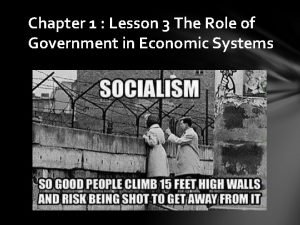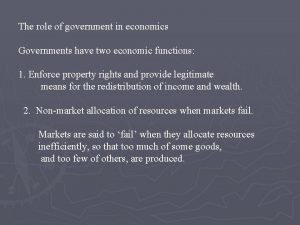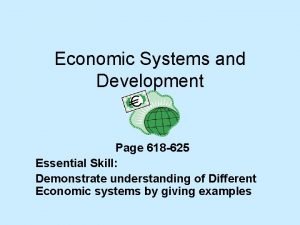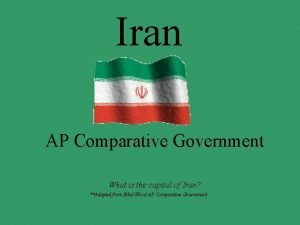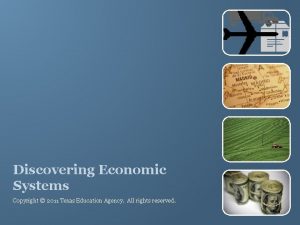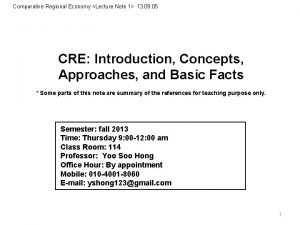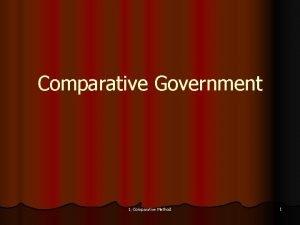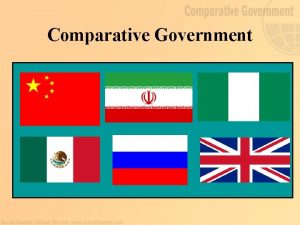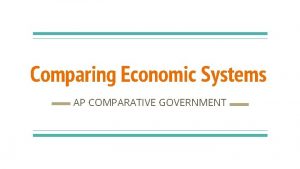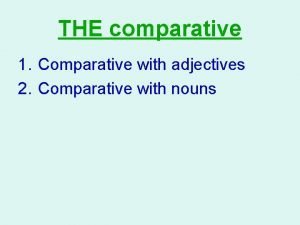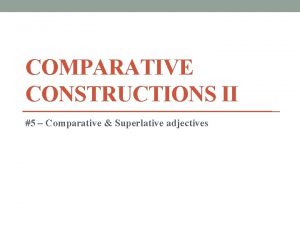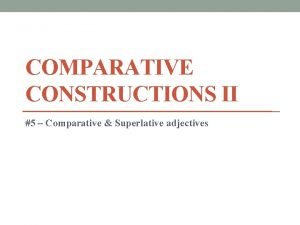AP Comparative Government Even with the economic downturn











- Slides: 11

AP Comparative Government

§ Even with the economic downturn of 2008, the economy of Mexico is significantly better than it was in the 1940’s § Infant mortality, literacy, and life expectancy have steadily improved § Improvements can also be seen in the quality of health care and education § The “Mexican Miracle” took place between 1940 and 1960 § The economy grew by more than 6% a year and industrial production rose by 9% for most of the 60’s § All of this growth took place without much inflation, therefore allowing citizens to have more buying power

§ Problems: § The growing gap between rich and poor was a major consequence of rapid economic growth § Between 1940 and 1980, Mexico had the most unequal income distribution among all LDC countries § While Mexico’s income inequality is not as bad as it was between 1940 and 1980, it is still an important issue today § Rapid and unplanned urbanization has forced people into living in shantytowns with no electricity, running water, or sewers § Traffic congestion in Mexico city is among the worst in the world and pollution is so bad it is unsafe to breathe in the city

§ During the gas crisis of the 1970’s, Mexico began producing more oil filling many of the gaps that OPEC had left in the oil market § Mexico was able to bring in massive oil revenues which led to economic growth in Mexico § Once the oil crisis was over, oil prices dropped sharply which devastated the Mexican economy § When oil prices dropped, it prevented Mexico from paying off all of the debt that incurred in building up their oil industry. § The Mexican debt was 70% of the nations GNP § In order to fix these debt issues, Miguel de la Madrid began his sexenio by instituting major reforms § Madrid was a believer in tecnico policies that pushed: § Sharp cuts in government spending: Jobs were cut, subsidies were slashed, and public enterprises were eliminated (due to agreements with the IMF, World Bank, U. S. Government and private banks) § Debt Reduction: Mexico significantly reduced their debt, but still pays around $10 billion in interest payments a year § Privatization: Companies were given the opportunity to compete and policies were passed that allowed free competition § Cheap labor and duty-free imports pushed for more global connection, especially with the U. S.

§ In 2006 President Calderon allowed PEMEX, the state run Mexican oil producing company, to have more autonomy in their running of the company § They were also allowed to higher independent contractors as a means of increasing the efficiency of the business § Energy reform failed with the U. S. recession in 2008 § 1/5 of Mexico’s GNP is tied to the oil trade with the U. S. § Exports of oil dropped by 36% hurting the Mexican economy badly § This economic dependency hurt Mexico much more than it did the rest of Latin America § During the 2012 election, Enrique Pena Nieto promised to reform PEMEX, not privatize it § PEMEX has been run at a deficit for years and has suffered two explosions § 2014 – Mexico began the process of inviting private oil companies to bid for new oil exploration blocks § The government hopes that foreign and private companies will team up with PEMEX increasing private energy investments in Mexico.

§ In 2013, Pena Nieto signed a far-reaching reform of the telecommunications and broadcast industries into law § Aimed at curbing the market power of big companies to increase competition and investment § Created Ifetel – regulatory body with power to regulate and force companies to sell assets § Company likely to be most affected – America Movil § 70% of wireless customers § 70% of fixed phone lines § Televisa SAB § 70% of broadcast TV market § TV Azteca § 30% of broadcast TV market § Two new digital networks planning on competing

§ In 1982, when the Mexican economy was hurt by the U. S. gas shortage, Mexico began to diversify their exports and decreased restrictions on foreign ownership of property § The Maquiladora is a major contributor to the Mexican economy § Maquiladoras are factories near the U. S. /Mexican border § In these factories U. S. raw goods are sent to Mexico where the goods are assembled and then sent directly back to the U. S. for sale § This is a duty-free exchange § Maquiladoras were promoted after the signing of NAFTA § Maquiladoras account for over 20% of the Mexican industrial labor force § The work force of Maquiladoras are predominately women who work for low pay, almost no benefits, and in buildings of questionable safety

§ GATT/WTO: In 1986 Mexico joined the General Agreement on Tariffs and Trade § This is the agreement that begat the WTO § Under this agreement Mexico expanded its offering of exports and helped the country diversify their economy beyond the sale of oil. § NAFTA: The North American Free Trade Agreement was signed by Mexico, Canada, and the United States § The goal of this agreement was to closely integrate economy by eliminating tariffs and reducing trade restrictions so that companies could expand into all countries freely. § Mexico received greater interests in big business, raw materials and tourism while the U. S. got access to a cheaper labor source and a greater trade impact throughout the world § 2011 – an agreement to allow Mexican trucks to cross into the US was reached

§ President Vincente Fox proposed a greater immigration policy in the U. S. § This plan called for a guest worker policy, amnesty for illegals working in the U. S. , and an increase in visas § This plan was met with great resistance and was further hurt by 9/11 § Under the Bush administration 600 miles of fence was built along the Mexican border to keep illegal immigrants out of the U. S. § In 2013, the United States proposed massive immigration reforms which have yet to pass through Congress § 2014 – Obama executive order for up to 4 million undocumented immigrants to live and work in US without fear of deportation § Never implemented b/c of court challenges § 2014 – Mexico began cracking down on a train route through Mexico from Central America (La Bestia) – harder for people to board illegally

§ The drug trade has created corruption in the Mexican government § The drug problem in Mexico is so bad that a raid had to be executed on a prison in order to break drug cartel control of the prison § When Calderon took office he stepped up the war on drugs, which set forth a wave of violence § This violence escalated quickly because of the massive competition between drug rings § Calderon widely used the military to police the streets to try and remove drug use § Police and government officials have now been the target of assassinations § In 2010 the murder rate in Mexico was 17 per 100, 000 § The fighting between the drug rings is concentrated in Ciudad Juarez which is near the U. S/Mexican border § In 2011, the U. S. increased their role in the fight against drugs by sending CIA agents to seek out and destroy drug rings § With the Election of President Pena Nieto, the U. S. role in fighting the drug cartels in Mexico has been reduced and centralized under Mexico’s federal Interior Ministry. § 2014 – 43 students in state of Guerrero disappeared § Mexican AG – students handed over by local police to a drug gang, which killed them because they believed the students were members of a rival gang § Report disputed and still under investigation

§ In order to solidify Mexico’s move towards democracy, the Instituto Federal Electoral (IFE) agency was created. The agency set rules that include: § Laws that limit contributions to campaigns § An allowance for critical media coverage of the government § The inclusion of international watch teams who can verify that elections are fair and competitive § Elections monitoring by opposition party members § Elections of 1994 and 2000 were observed to be the most competitive and fair in history § 2006 – Competitive election, but Obrador’s questioning of the legitimacy made democracy fragile § Eventually, his own party criticized him for his behavior § 2013 – State and local election violence § Six candidates killed, another wounded § Numerous assaults of family members and party/campaign officials § Mostly in small towns – less protected from violence by drug cartels and organized crime groups § 2012 – Pena Nieto’s “Pact for Mexico” § 95 loosely defined proposals signed by all three main parties § Hoped that the parties would work together for all of Mexico § Nieto’s cabinet – PRI technocrats and party stalwarts, PAN finance officials, a former leader of PRD
 Language
Language Regular expression of even even language
Regular expression of even even language National government vs federal government
National government vs federal government Lesson 3 the role of government in economic systems
Lesson 3 the role of government in economic systems Economic role of government
Economic role of government Role of government in economic development
Role of government in economic development Economic growth vs economic development
Economic growth vs economic development Economic growth vs economic development
Economic growth vs economic development Economic systems lesson 2 our economic choices
Economic systems lesson 2 our economic choices Iran ap comparative government
Iran ap comparative government Discovering economic systems guided practice
Discovering economic systems guided practice Economic comparative and superlative
Economic comparative and superlative



